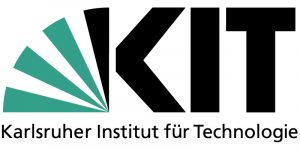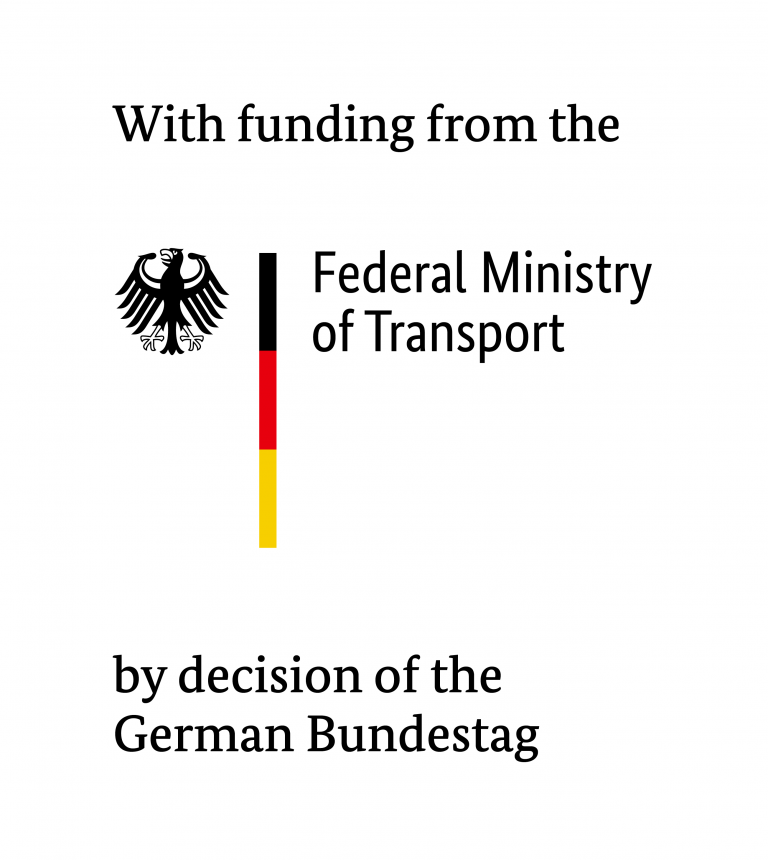In the KIRA project, Level 4 autonomous vehicles are being tested in on-demand service for the first time in Germany – an important step for the mobility transition!
Initiated by:


Funded by:
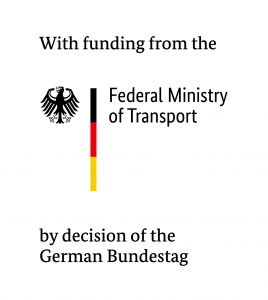
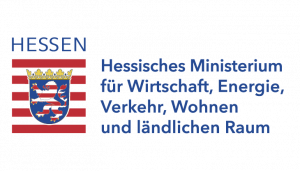
Autonomous vehicles operating at regular speeds in German public transport
Self-driving cars that take part in normal road traffic in a defined service area at normal speed – this is becoming a reality for the first time in Germany with KIRA, AI-based regular operation of autonomous on-demand transport. The project is kicking off in Darmstadt and the district of Offenbach.
Autonomous driving is a crucial step for the expansion of public transport and the implementation of the mobility transition, particularly in times of driver shortages. The electrically powered on-demand shuttles, which can be booked via an app, are an important element of public transport services, particularly in rural area and small towns.
Self-driving cars that take part in normal road traffic in a defined service area at normal speed – this is becoming a reality for the first time in Germany with KIRA, AI-based regular operation of autonomous on-demand transport. The project is kicking off in Darmstadt and the district of Offenbach.
Autonomous driving is a crucial step for the expansion of public transport and the implementation of the mobility transition, particularly in times of driver shortages. The electrically powered on-demand shuttles, which can be booked via an app, are an important element of public transport services, particularly in rural area and small towns.
The Rhine-Main Regional Transport Association (RMV) and Deutsche Bahn are collaborating with local partners HEAG mobilo and Kreisverkehrsgesellschaft Offenbach to realise the project with support from the German Federal Ministry for Digital and Transport and the State of Hesse. Technology partners are Mobileye, ioki and Bosch.
The results of the project will be analysed together with the German Aerospace Center (DLR), the Karlsruhe Institute of Technology (KIT) and dmo mobility consultants and compiled into a guideline by the Association of German Transport Companies (VDV).
The project phases
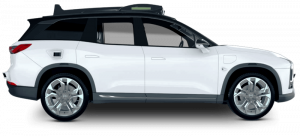
- concluded
Phase 1: Project set-up
- Rough transport concept
- Partnerships
- Financing and funding
- Legal framework
- Local decision-making processes
Phase 2: Implementation
- Obtaining permits
- Development of operational processes
- Programming software and interfaces
- Setting up operations and headquarters
- active
Phase 3: Operation
3.1 : Calibration drives
- Vehicle collects environmental and traffic data
- Vehicle drives autonomously, without passengers, with safety personnel on board
- Testing with project employees as passengers
- in planning
3.2: Trial operation
- Set-up of a closed group of test users
- On-demand service with test users and safety personnel on board
- User acceptance research and traffic analyses
- Optimisation of technology and processes based on customer feedback
- Drafting of a guideline for the industry
The operating area
To learn how autonomous on-demand vehicles can be integrated into existing public transport services in the long term, it is important to gather experience in both rural and urban transport environments.
The KIRA shuttles operate in parts of the city of Darmstadt and in the western part of the Offenbach district. They move freely on the approved road network while always choosing the best route.
The operating area will be gradually expanded with the start of the test rides.
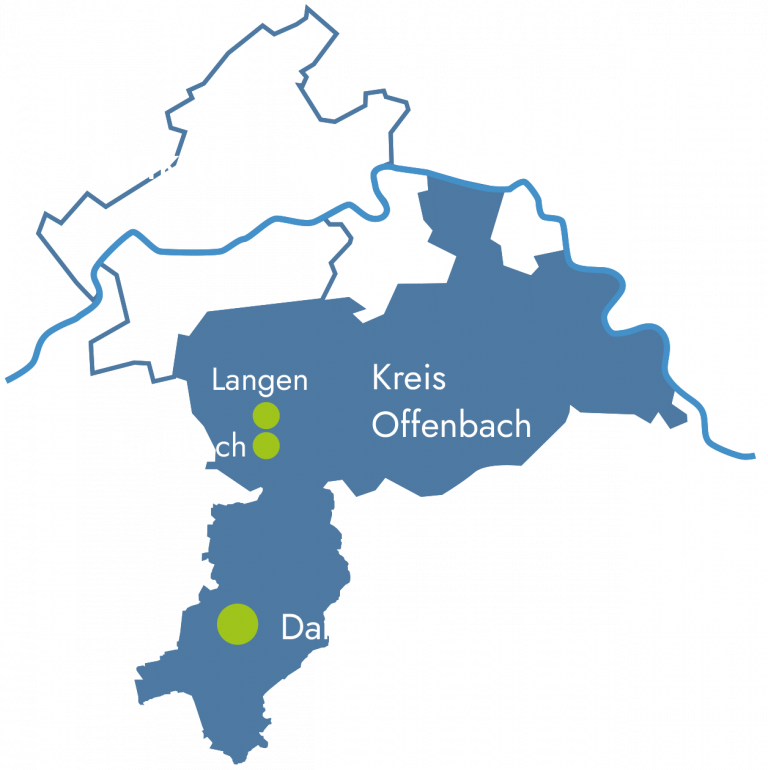
The technology: redundant sensor systems, modern vehicles and highly specialised personnel provide for safety and a high level of ride comfort
The autonomous driving system: KIRA uses the Mobileye Drive™ autonomous driving system. The system integrated into the KIRA vehicles is based on a combination of camera, radar and lidar sensors as well as intelligent data from the driving environment. A mathematical safety model also provides a set of rules for autonomous driving.
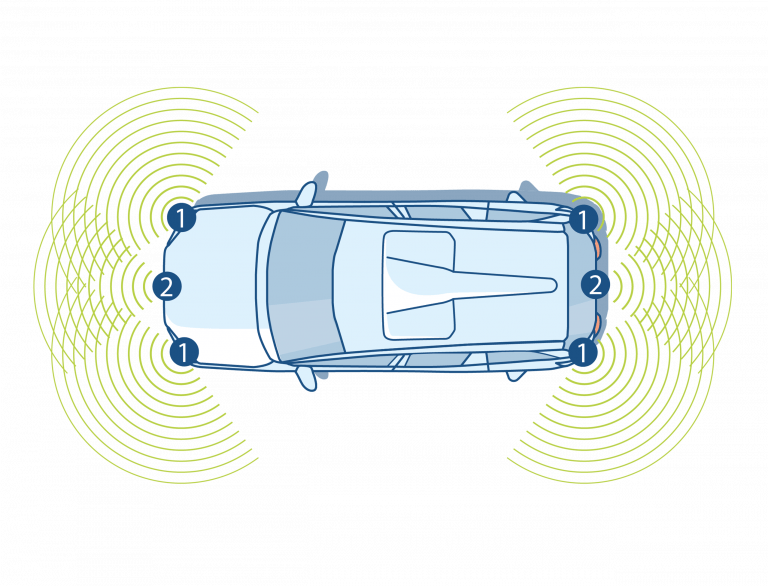
Radar sensors
- 4 x short-range radars
- 2 x long-range radars
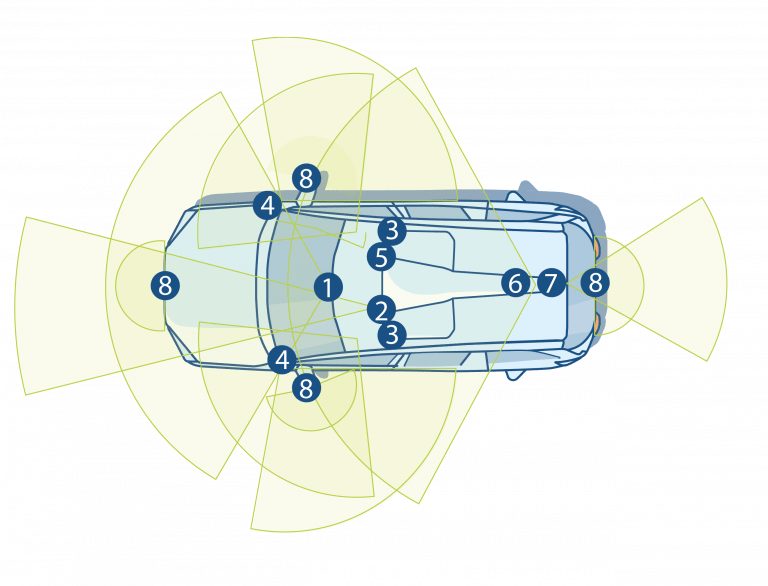
Cameras
- Main front-facing 8 MP camera
- Narrow front-facing 8 MP camera
- 2 x side-front 8 MP cameras
- 2 x side-rear 8 MP cameras
- Backup camera
- Traffic light 8 MP camera
- Rear 8 MP camera
- 4 x 2MP short-range surround cameras
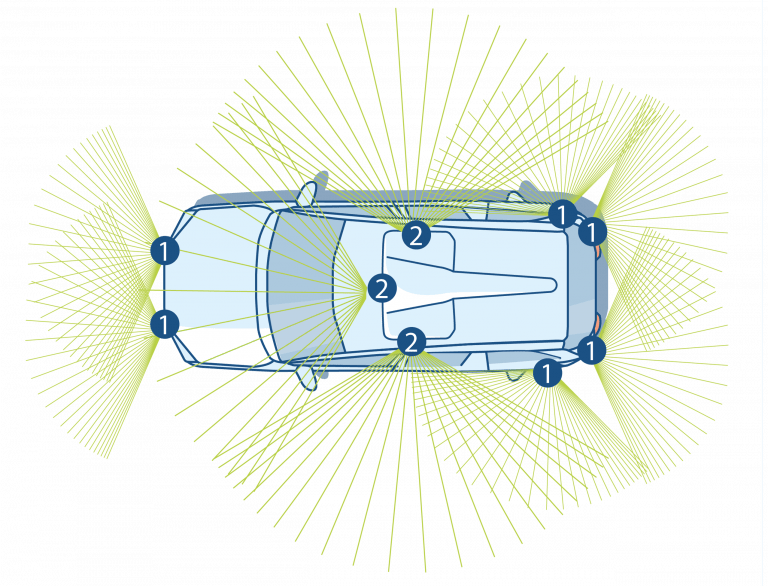
Lidar sensors
- 6 x short-range lidars
- 3 x long-range lidars
Both systems – camera and radar/lidar – work independently. Should one system fail, the other system can continue to ensure operation.
The advantage of using different sensors is that a comprehensive model of the driving environment is produced at all times and the vehicle can be operated autonomously, including in adverse weather conditions, for example.
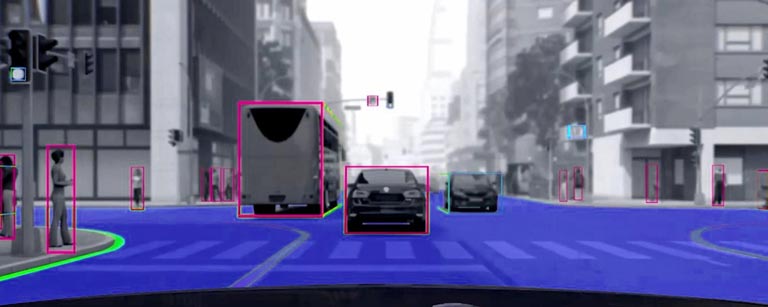
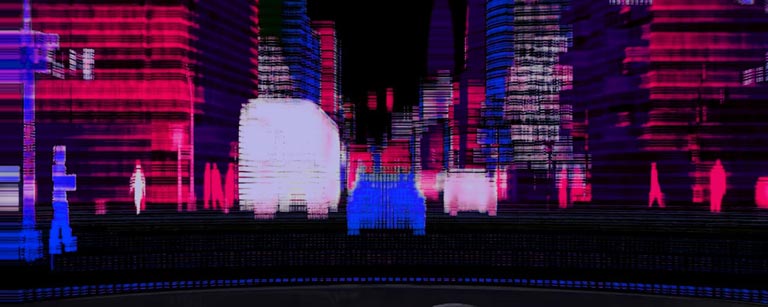
Climb aboard! (virtually)
Scene 1: Crossing traffic without traffic lights
The autonomous vehicle observes through traffic and pedestrians in order to find a suitable gap for turning without slowing down the flow of traffic.
Source: mobileye
Scene 2: Pedestrians and crosswalks
Pedestrians cross the road in front of the vehicle. The autonomous vehicle slows down, signaling to pedestrians that they can pass.
Source: mobileye
Scene 3: Obstacle blocks the road
A road user blocks the lane of the autonomous vehicle. Based on the traffic situation, the vehicle decides that a cautious overtaking maneuver is possible.
Source: mobileye
Climb aboard! (virtually)
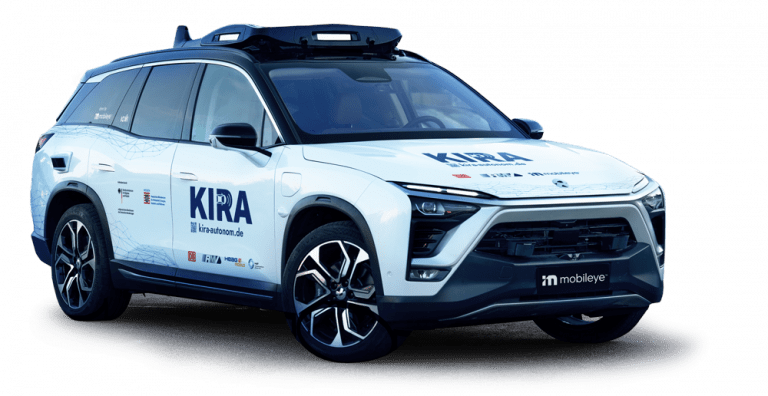
The vehicle
The NIO ES8 with the Mobileye autonomous driving system installed can master complex driving situations and drives autonomously at normal speeds of up to 130 km/h. The electric vehicle has a range of approximately 400 km and can seat three passengers in the configuration for KIRA trial service.
For safe autonomous driving
One of the most important trial operation objectives is to gradually test and optimise all safety-relevant processes. The legal basis for this is provided by the Autonome-Fahrzeuge-Genehmigungs-und-Betriebsverordnung (Autonomous Vehicle Authorisation and Operation Ordinance), which is being applied here for the first time in public transport.
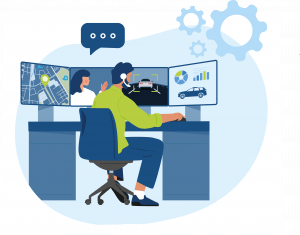
Technical supervision
Technical supervision in the control centre is an important element of autonomous driving for later regular operation without a safety driver. Technical supervision is being tested as part of the project. Employees monitor the vehicles and approve manoeuvres after assessing the situation on the basis of camera images and data.
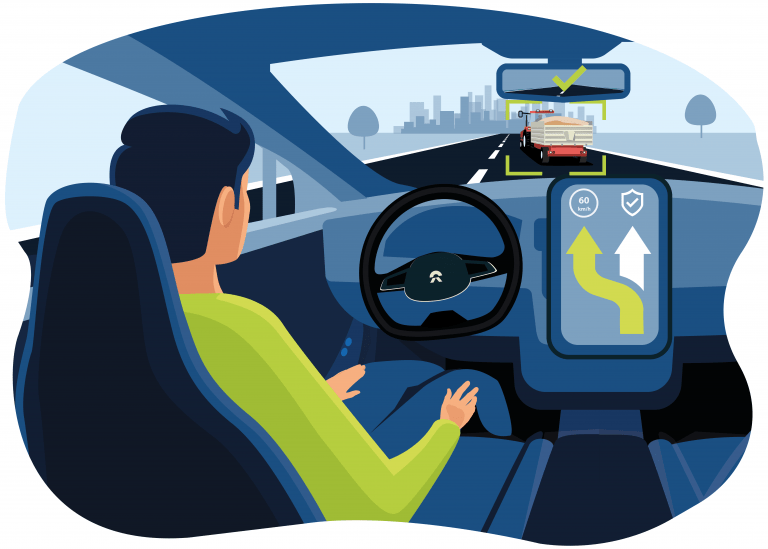
Safety driver
During KIRA trial operation, trained safety personnel will be on board at all times to monitor, validate and intervene in the event of an incident. Other than that, the safety drivers do not use their hands or feet, i.e. the vehicle drives completely autonomously.
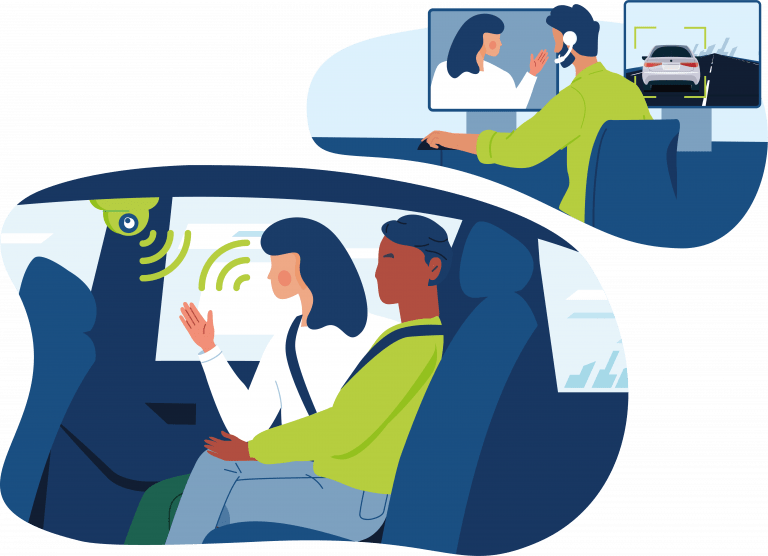
Digital passenger assistance in the cabin
A digital cabin management system enables audiovisual interaction between passengers and Technical Supervision. In the event of an incident, passengers can initiate contact via an easily visible button.
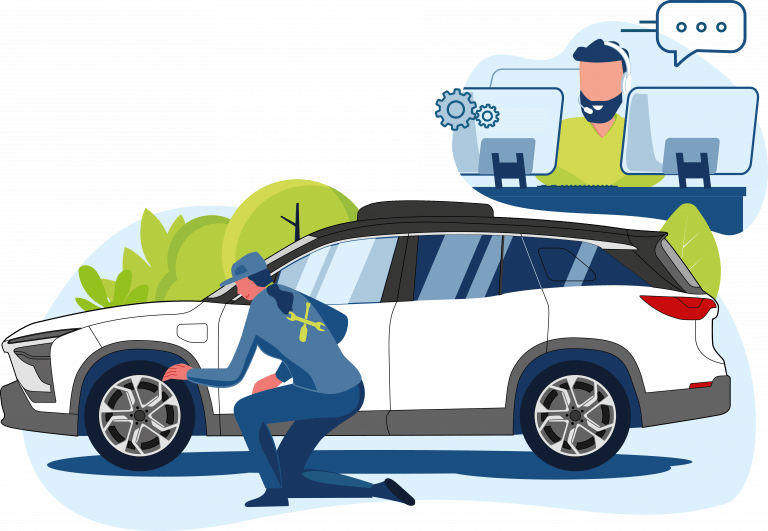
Field team
As with other public transport services, a team of technical specialists is available at KIRA in the event of unplanned incidents and can resolve any problems on site.
A strong partner network from transport, technology, government, industry and science for the public transport of the future
KIRA is a research and development project. Strong partners characterised by a willingness to innovate and dedication are crucial to its success. Each project partner contributes its own expertise, products and services.
FAQs about autonomous driving with KIRA
Autonomous driving – general information
Autonomous driving means that a vehicle drives on the road without a human driver. Instead of the driver, an intelligent autonomous driving system takes control of the vehicle and makes independent decisions in road traffic.
There are five stages of automated driving. Level 4 is highly automated, i.e. vehicles are driverless, remotely monitored by a technical supervision and can move autonomously within a defined operating area. With Level 3, on the other hand, drivers are always required as a fallback level, partly because Level 3 technology is not yet able to deal with complex traffic situations. In contrast to Level 4, vehicles with a Level 5 system can drive autonomously everywhere, not just in a defined operating area. They do not require remote monitoring. However, level 5 has not yet been achieved worldwide and is not a necessity for the use case of public transport – and therefore for the mobility transition.
In Europe, and particularly in Germany, there are currently no Level 4 vehicles deployed in public transport in Europe. Internationally, Level 4 vehicles are being tested and some are in passenger service, particularly in California (USA) and China.
Attractive and comprehensive public transport is crucial for the mobility transition. On-demand transport services play a key role here. They support classic scheduled rail and bus service and close both geographic and temporal service gaps. However, there are not enough drivers available for the necessary expansion of scheduled and on-demand transport services. Autonomous driving closes this gap. Autonomous vehicles solve the problem of driver shortages and enable a more closely linked public transport network, even outside rush hours.
The aim of the project is to prove that the technology is ready for regular public transport operations.
No, there are already far too few drivers in public transport. If the mobility transition is to succeed and there is to be a greater range of public transport services offered, the demand for drivers will tend to increase. This demand, which is becoming increasingly difficult to meet, can be compensated for by the use of autonomous technology. Autonomous driving will create new, more attractive job profiles, such as in technical supervision. New development paths are emerging for young drivers starting their careers today. This makes the profession of driver more attractive.
Operations and service
The operation with a limited group of users started on May 28, 2025.
The trial operation covers areas in the city of Darmstadt (Darmstadt Central Station, Darmstadt-Nord, Johannesviertel, Kranichstein, Wixhausen, Arheilgen) and the western part of the Offenbach district (Langen and Egelsbach). The autonomous vehicles are intended to supplement urban and rural on-demand transport services and will be tested in parallel with the existing driver-based on-demand services ‘HeinerLiner’ and ‘Hopper’. The vehicles move freely within the test area, always selecting the best route as on-demand transport services.
The operating hours are initially Wednesday to Friday from 9:30 a.m. to 3:30 p.m., excluding public holidays.
During calibration drives, the autonomous shuttles familiarise themselves with the operating area in detail with the help of available map and traffic data. This involves checking how the vehicles behave on the specified routes and in the existing traffic situations.
The KIRA project includes six vehicles.
Yes, KIRA is an on-demand service, meaning the vehicles are ordered via an app as needed, and additional passengers with similar destinations are picked up or dropped off along the way. This means the ride is shared with other travelers if there is corresponding demand. We use the software for the app and matching algorithm from our project partner ioki.
The autonomous shuttles drive in regular public road traffic at the usual speed for the roads in the areas and of course comply with traffic regulations. The vehicles float along in traffic like a normal vehicle.
Safety
The certification of autonomous vehicles to Level 4 according to the new legislation of the Autonomous Vehicle Authorisation and Operation Ordinance (AFGBV) places high demands on the safety of the driving system, the vehicle and the accompanying operational processes. Fulfilling these requirements ensures that autonomous traffic is at least as safe as a human driver. To guarantee that these requirements are met, the safety level is usually significantly higher. Statistically, each autonomous vehicle already increases safety on German roads.
Despite the safety driver, the vehicles are monitored remotely by trained personnel in a technical control centre in accordance with legal requirements. These processes are also to be trialled in the end. In future driverless transport, the law stipulates that the vehicle will contact the technical control centre in difficult traffic situations. The vehicle suggests various driving manoeuvres. The technical Supervision can then select a manoeuvre or put the vehicle into a safe state. If the trained personnel decide to do the latter or are too late, the vehicle is brought to a safe stop by the autonomous technology and waits for new instructions. The test approval stipulates that the technical supervisor must be in the vehicle, so the safety personnel on board also perform the tasks of the technical supervisor. We test the technical supervisor in the control centre in our project.
The safety driver serves two functions during trial operation: First, he/she monitors the safety of the test drives and intervenes if necessary. Second, he/she documents the driving performance. This helps the developers to “train” the system more precisely and adjust it to the driving environment. Depending on the driving situation, the safety driver will have their hands on the wheel or places them in their lap and let the vehicle drive autonomously.
In the unlikely event the safety driver fails, the vehicle performs a so-called “minimal risk manoeuvre”, i.e. the autonomous technology brings it to a safe stop.
Yes, KIRA is an autonomous Level 4 operation. A Level 4 test authorisation has been granted on the basis of Section 16 AFGBV. With this authorisation, vehicles with Level 4 technology can be tested in Germany in accordance with the new AFGBV regulation. The law requires a safety driver for the trial period.
The legal requirements are fully met.
The Mobileye system consists of two completely redundant self-driving systems. One system is camera-based, the other system is based on lidar and radar sensors. Both systems can control the vehicle completely autonomously. If one system fails, the vehicle can continue to drive as normal. In test operation, there is also a safety driver who is always available as a backup.
The legal requirements are met in full, see LINK (privacy policy environmental data).
FAQs about autonomous driving with KIRA
Autonomous driving – general information
Autonomous driving means that a vehicle drives on the road without a human driver. Instead of the driver, an intelligent autonomous driving system takes control of the vehicle and makes independent decisions in road traffic.
There are five stages of automated driving. Level 4 is highly automated, i.e. vehicles are driverless, remotely monitored by a technical supervision and can move autonomously within a defined operating area. With Level 3, on the other hand, drivers are always required as a fallback level, partly because Level 3 technology is not yet able to deal with complex traffic situations. In contrast to Level 4, vehicles with a Level 5 system can drive autonomously everywhere, not just in a defined operating area. They do not require remote monitoring. However, level 5 has not yet been achieved worldwide and is not a necessity for the use case of public transport – and therefore for the mobility transition.
In Europe, and particularly in Germany, there are currently no Level 4 vehicles deployed in public transport in Europe. Internationally, Level 4 vehicles are being tested and some are in passenger service, particularly in California (USA) and China.
Attractive and comprehensive public transport is crucial for the mobility transition. On-demand transport services play a key role here. They support classic scheduled rail and bus service and close both geographic and temporal service gaps. However, there are not enough drivers available for the necessary expansion of scheduled and on-demand transport services. Autonomous driving closes this gap. Autonomous vehicles solve the problem of driver shortages and enable a more closely linked public transport network, even outside rush hours.
The aim of the project is to prove that the technology is ready for regular public transport operations.
No, there are already far too few drivers in public transport. If the mobility transition is to succeed and there is to be a greater range of public transport services offered, the demand for drivers will tend to increase. This demand, which is becoming increasingly difficult to meet, can be compensated for by the use of autonomous technology. Autonomous driving will create new, more attractive job profiles, such as in technical supervision. New development paths are emerging for young drivers starting their careers today. This makes the profession of driver more attractive.
Registration, booking and utilisation
All citizens over the age of 18 can register for the registration process. The project partners are particularly interested in test users who use the service more frequently, i.e. live in the Darmstadt/Kreis Offenbach area or travel there often. However, test users are not obliged to take a certain number of rides.
KIRA is a research and development project, not a public offering. In order to get meaningful test results, it is important to have as heterogeneous a group of participants as possible. Therefore, we ask for some information when registering, and on this basis we compile the participants.
The research partners, DLR – German Aerospace Center and KIT – Karlsruhe Institute of Technology, are supporting the KIRA project and conducting an analysis on the acceptance of autonomous driving. We kindly ask test users to share their experiences with the autonomous transport service. This feedback will help to make future autonomous transport offerings more user-friendly.
Yes, the rides with the autonomous vehicles are free. They are paid, so to speak, with the feedback provided by participating in surveys. The feedback helps make the autonomous vehicles more customer-friendly.
Test users can conveniently book and use the vehicles via the app. By agreeing to participate, all test users will receive a link to download a booking app and further information.
Test users open the vehicle via the KIRA app, which then identifies them as customers. If that doesn’t work, the on-board security driver takes over the door opening and identification.
The aim of the test operation is to test the fully autonomous use of the vehicles on public transport and to explore the effects of non-existent interaction with a driver. The security personnel are encouraged to keep interaction with test users to a minimum, including to test the digital passenger accompaniment in the interior.
In case of critical events, the security personnel in the vehicle are always active and approachable. To test future customer processes, test users should still press the “Assistance Button” in the vehicle to contact Customer Support. This communication method is very important for autonomous transport.
No, during the trial operation, each test user must register individually and book for themselves. This is important for user acceptance research to assign the corresponding users and their experiences to the rides.
During the trial operation, only persons aged 18 and over can use the service.
There are 3 seats available for passengers in the back seat of the test vehicle.
Unfortunately, pets cannot be brought along. There is no space for large luggage in the trunk as it contains the technology. Luggage that can be held on your lap during the ride can be transported.
Unfortunately, the pilot vehicles used are not barrier-free. As soon as autonomous barrier-free vehicles are offered on the market, we will use them in future operations.
Operations and service
The operation with a limited group of users started on May 28, 2025.
The trial operation covers areas in the city of Darmstadt (Darmstadt Central Station, Darmstadt-Nord, Johannesviertel, Kranichstein, Wixhausen, Arheilgen) and the western part of the Offenbach district (Langen and Egelsbach). The autonomous vehicles are intended to supplement urban and rural on-demand transport services and will be tested in parallel with the existing driver-based on-demand services ‘HeinerLiner’ and ‘Hopper’. The vehicles move freely within the test area, always selecting the best route as on-demand transport services.
The operating hours are initially Wednesday to Friday from 9:30 a.m. to 3:30 p.m., excluding public holidays.
During calibration drives, the autonomous shuttles familiarise themselves with the operating area in detail with the help of available map and traffic data. This involves checking how the vehicles behave on the specified routes and in the existing traffic situations.
The KIRA project includes six vehicles.
Yes, KIRA is an on-demand service, meaning the vehicles are ordered via an app as needed, and additional passengers with similar destinations are picked up or dropped off along the way. This means the ride is shared with other travelers if there is corresponding demand. We use the software for the app and matching algorithm from our project partner ioki.
The autonomous shuttles drive in regular public road traffic at the usual speed for the roads in the areas and of course comply with traffic regulations. The vehicles float along in traffic like a normal vehicle.
Safety
The certification of autonomous vehicles to Level 4 according to the new legislation of the Autonomous Vehicle Authorisation and Operation Ordinance (AFGBV) places high demands on the safety of the driving system, the vehicle and the accompanying operational processes. Fulfilling these requirements ensures that autonomous traffic is at least as safe as a human driver. To guarantee that these requirements are met, the safety level is usually significantly higher. Statistically, each autonomous vehicle already increases safety on German roads.
Despite the safety driver, the vehicles are monitored remotely by trained personnel in a technical control centre in accordance with legal requirements. These processes are also to be trialled in the end. In future driverless transport, the law stipulates that the vehicle will contact the technical control centre in difficult traffic situations. The vehicle suggests various driving manoeuvres. The technical Supervision can then select a manoeuvre or put the vehicle into a safe state. If the trained personnel decide to do the latter or are too late, the vehicle is brought to a safe stop by the autonomous technology and waits for new instructions. The test approval stipulates that the technical supervisor must be in the vehicle, so the safety personnel on board also perform the tasks of the technical supervisor. We test the technical supervisor in the control centre in our project.
The safety driver serves two functions during trial operation: First, he/she monitors the safety of the test drives and intervenes if necessary. Second, he/she documents the driving performance. This helps the developers to “train” the system more precisely and adjust it to the driving environment. Depending on the driving situation, the safety driver will have their hands on the wheel or places them in their lap and let the vehicle drive autonomously.
In the unlikely event the safety driver fails, the vehicle performs a so-called “minimal risk manoeuvre”, i.e. the autonomous technology brings it to a safe stop.
Yes, KIRA is an autonomous Level 4 operation. A Level 4 test authorisation has been granted on the basis of Section 16 AFGBV. With this authorisation, vehicles with Level 4 technology can be tested in Germany in accordance with the new AFGBV regulation. The law requires a safety driver for the trial period.
The legal requirements are fully met.
The Mobileye system consists of two completely redundant self-driving systems. One system is camera-based, the other system is based on lidar and radar sensors. Both systems can control the vehicle completely autonomously. If one system fails, the vehicle can continue to drive as normal. In test operation, there is also a safety driver who is always available as a backup.
The legal requirements are met in full, see LINK (privacy policy environmental data).
Contact
Would you like to contact us or do you have additional questions?
- Representatives of the press should please contact pressestelle@rmv.de or presse@deutschebahn.com
- General questions: Please use our contact form

